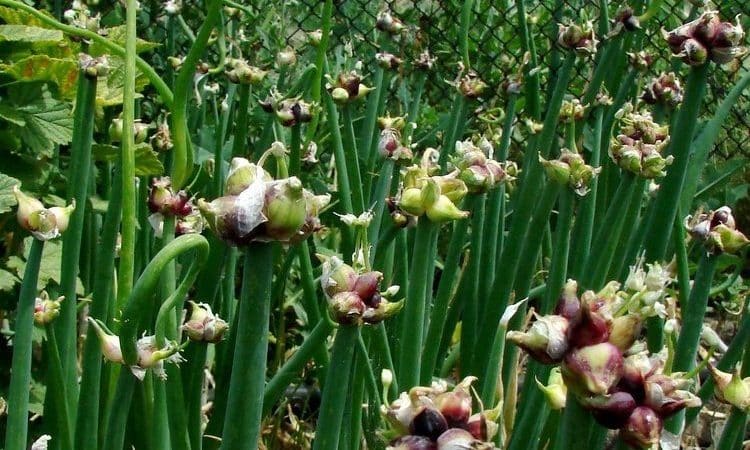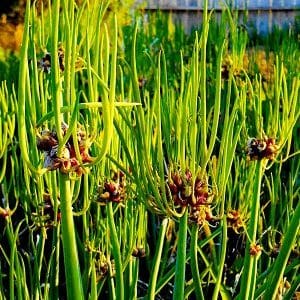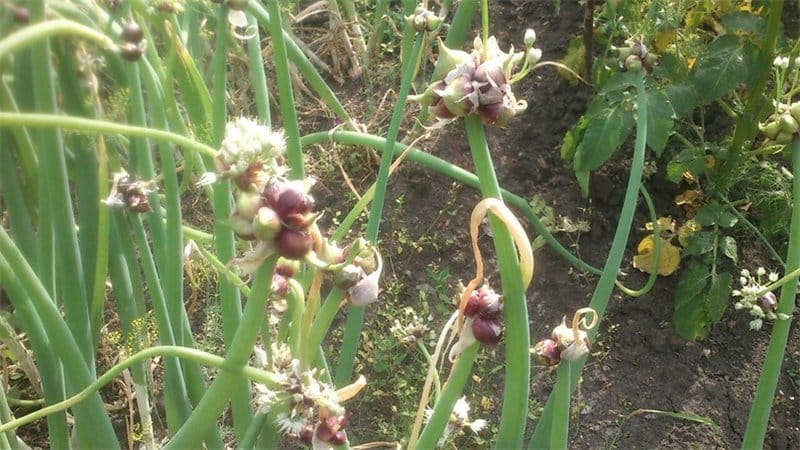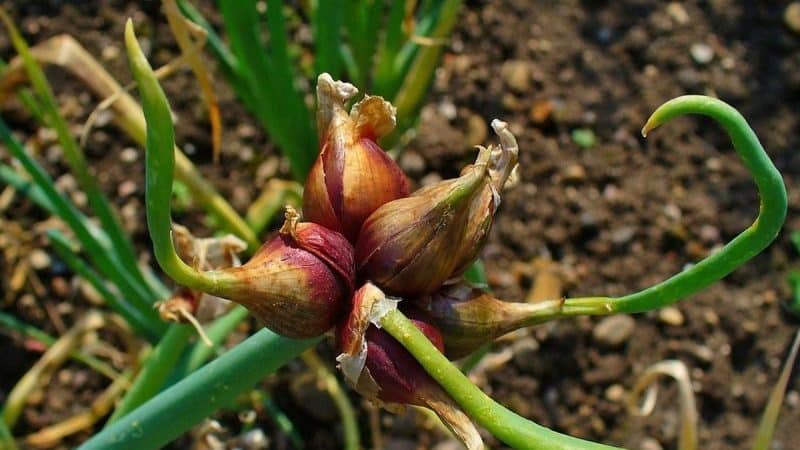Unpretentious in cultivation and care “Multi-tiered” onions
Unusual multi-tiered onions have been grown in Russia for a long time. Farmers appreciated the positive qualities of this crop, which were also complemented by the decorative appearance of the plant. When you decide to grow this onion, take into account the important nuances of its planting and the requirements necessary to obtain a good harvest.
Description
Multi-tiered (horned, Egyptian, walking, Canadian, viviparous) onion is a type of perennial herbaceous hybrid plant of the Onion family, all parts of which can be eaten.

Origin and development
Despite the name, the birthplace of Canadian onions is China.. It was from there that the culture came to Europe more than 200 years ago. The species appeared as a result of crossing onion onions and onions-batuna. The state register of the Russian Federation includes information about three varieties of multi-tiered onions.
The originator of the Likova and Pamyat varieties is the Federal Scientific Center for Vegetable Growing; they were included in the state register in 1987 and 2005, respectively. The originator of the Chelyabinsk variety is LLC NPO "Garden and Vegetable Garden", included in the state register in 2012.
Chemical composition, trace elements and vitamins and beneficial properties
Egyptian onions contain:
- ascorbic acid;
- carotene;
- vitamins B, B2, PP;
- Sahara;
- essential oils;
- nickel;
- potassium;
- cobalt;
- iron;
- zinc;
- manganese;
- copper;
- boron;
- calcium;
- phosphorus;
- molybdenum;
- phytoncides.
Onions have antiviral and anti-inflammatory effects, are beneficial for the digestive system, enhance the body's protective functions, promote the production of collagen and elastane, normalize blood pressure and regenerate mucous membranes.
Eating this vegetable stabilizes the functioning of the cardiovascular system and increases the tone of the walls of blood vessels.
Ripening time and yield
All varieties of multi-tiered onions registered in the state register of Russia are early ripening - the crop is ready for harvest 20-24 days after the massive regrowth of leaves.
Productivity depends on the variety:
- Likova - up to 3.6 kg per square meter. m.;
- Memory – up to 3 kg per 1 sq. m., greenery - 0.7 kg per 1 sq. m, aerial bulbs - 0.7 kg per 1 sq. m.;
- Chelyabinsk - 1.6 kg per 1 sq. m of green leaves (one cut), 0.6 kg per 1 sq. m. air bulbs.
Disease resistance
Onions have stable immunity to most diseases characteristic of the crop, except for downy mildew.
Characteristics of the bulb, description of appearance, taste

During the growing season, the plant forms up to three peduncles 60-100 cm high, which grow in layers and are dotted with small above-ground bulbs weighing 15-25 g.
Each plant has 2-3 tiers: on the bottom there are the largest heads, the diameter of which reaches 3 cm, on the upper rows there are smaller fruits, and there are more of them.
The leaves of multi-tiered onions are dark green, tubular, hollow, grow up to 45-55 cm in height and up to 2 cm in width. The bulbs are round-oval in shape, covered with brown, yellow or purple husks. The taste is spicy or semi-sharp.
For which regions is it best suited and what are the climate requirements?
Walking onions are unpretentious to climatic conditions and are suitable for growing in all regions.
Main advantages and disadvantages
Advantages of a multi-tiered bow:
- frost resistance;
- strong immunity;
- lack of dormancy in the bulbs;
- rapid growth of greenery even with a lack of light;
- early maturation;
- unpretentiousness;
- Possibility of cultivation in all regions.
Minuses:
- tendency to peronosporosis;
- propagation only by vegetative means;
- short-term storage.
What is the difference from other types of onions?
The main distinctive features of a multi-tiered bow:
- only this onion grows in several tiers;
- loose structure of underground bulbs, which after some time are divided into parts;
- greens do not become coarse for a long time;
- fruiting throughout the entire growing season;
- in a few years the roots grow up to 1.5 m in length;
- Under snow, onions can withstand frosts down to -45°C.
Features of planting and growing
Egyptian onions have no seeds, so they can only be propagated vegetatively: by underground or aerial bulbs.
When planting crops, certain rules are followed - this is the only way to count on abundant yields.

Preparing for landing
In the case of onion propagation using underground bulbs, the overgrown mother bulb is divided into several parts, obtaining planting material ready for transplanting to other beds. When propagated by aerial bulbs, the heads are collected from the second or third tier and sorted by size, since sowing rates and harvesting times depend on this.
Before planting, the bulbs are soaked for 3-5 minutes in a solution of potassium permanganate for disinfection, and then dried thoroughly.If planting is not planned soon, put the bulbs in a paper bag and put them in a cool place.
Reference. Planting material is collected before the plant produces green arrows.
The soil on the site is carefully dug up and organic (compost, humus) or mineral fertilizers are added to it. If it is necessary to deoxidize the soil, chalk, gypsum, lime or wood ash are added to it.
Soil requirements
Maximum yields are obtained in fertile soil with good moisture permeability, aeration and neutral acidity, for example, loam. In acidic soil, the crop does not develop well.
Dates, scheme and rules of planting
There are three optimal times for planting multi-tiered onions:
- after harvest - late August or September;
- before winter - late October-early November;
- early spring – early March.
When planting before winter, the crop may not have time to take root before the onset of frost, so the beds must be covered.
Planting pattern:
- Form rows for planting on the site at a distance of 25-30 cm from each other.
- Make planting holes in them.
- Plant the bulbs in the ground. Large specimens are planted every 20 cm, deepened by 10 cm. The distance between medium-sized bulbs should be 8-10 cm, and the planting depth should be 8 cm; small heads should be buried by 5 cm, leaving 6 cm between them.
- Sprinkle the bulbs with soil, water it and mulch the beds with humus.
Features of cultivation
The place for planting the crop should be located on a hill, since groundwater and snow water often accumulate in the lowlands, which leads to plant rotting.
Multi-tiered onions can be grown in the same place for a maximum of five years in a row, after which the beds are changed.
The best predecessors of onions are potatoes, cabbage, beets, and zucchini.
Nuances of care
This culture does not require complex care. It is enough to ensure the correct landing watering and fertilizing, loosen the soil and do not neglect the preventive treatment of plants against diseases and pests.
Watering mode
Under favorable weather conditions, water the onions three times a week using settled water heated to approximately +37°C.
Loosening the soil and weeding
The soil is loosened 2-3 times per season - this improves the access of oxygen, nutrients and moisture to the underground bulbs. Most often, the procedure is combined with trimming greenery or applying fertilizer.
Weeding is carried out as necessary, removing weeds from the soil that create shading, take macro- and microelements necessary for the crop from the soil and attract pests.
Top dressing
For intensive growth of greenery, self-prepared organic fertilizers are used:
- ash solution – dilute 1.5 tbsp in 10 liters of water. wood ash, mix and pour into furrows for irrigation;
- mullein – dilute 1 liter of manure in 10 liters of water, leave for a week, then mix 1 liter of the resulting solution with 5 liters of water and water the row spacing with this mixture;
- chicken droppings – mix 1 liter of bird droppings with 1 liter of water, leave for three days, then dilute 1 liter of the resulting solution in 10 liters of water and pour the mixture over the row spacing;
- mineral fertilizer – dilute 60 g of complex mineral fertilizer in 10 liters of water and pour the solution over the soil between the rows.
After applying fertilizing, a sprinkling procedure is carried out - this helps to wash off the fertilizers from the plants.
Disease and pest control
The main danger for multi-tiered onions is downy mildew.. To prevent the development of the disease, plants are sprayed with Bordeaux mixture.
Of the pests, onion flies most often attack plantings. Insecticidal preparations are used to control insects.
Harvest and storage

Multi-tiered onions have some features not only in planting, but also in harvesting and storage harvest.
How and when to collect
In order not to encounter the problem of reducing the number of aerial bulbs, greens from onions are cut a maximum of two times per season: approximately 2.5 weeks after sowing the onions and 3 weeks after.
The bulbs are harvested during the ripening of the bulbs, when the heads acquire a brown tint and a bluish coating forms on them.
Storage features and keeping quality of the variety
The collected bulbs are inspected and calibrated, some are set aside for later planting, others for consumption and storage.
Store onions in wooden boxes with sand in a dark, well-ventilated room with a humidity of 75% and an air temperature of -3...+2°C for a maximum of 3-4 months.
What difficulties may there be when growing
When cultivating Egyptian onions, you may encounter some problems:
- rotting of plants at high soil moisture;
- slow development of onions if they are planted in soil with high acidity.
Advice from experienced gardeners
Experienced farmers recommend:
- Do not grow this onion in one place for more than five seasons in a row - this depletes the soil, which affects the quality and volume of the harvest.
- If the plants are dead, tie the upper tiers into bunches and tie them on pegs.
- 3-4 weeks before planting onions, apply organic fertilizers high in nitrogen to the soil, which stimulates green growth.
Reviews about the Multi-tiered onion variety
Reviews from vegetable growers, which can be found on specialized forums, are positive:
Vera, Grozny: «I’ve been growing multi-tiered onions for many years now and I don’t understand those who haven’t at least tried to plant them. In addition to being delicious, it is also very beautiful - like some kind of alien plant. And, of course, its frost resistance and minimal maintenance requirements are captivating.”
Svetlana, Tula: “This is definitely the most unusual bow I have ever seen. A neighbor gave me multi-tiered onion bulbs about seven years ago, I planted them and realized that they were mine. I like its frost resistance, unpretentiousness and pleasant taste.”
Conclusion
Multi-tiered onions are one of the best perennial crops. It does not require labor-intensive care, is suitable for cultivation in all regions of Russia, has a pleasant taste, is resistant to frost and disease, and has an unusual, decorative appearance.